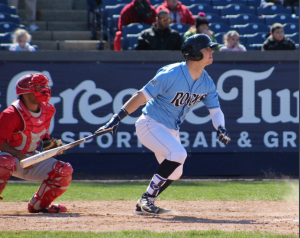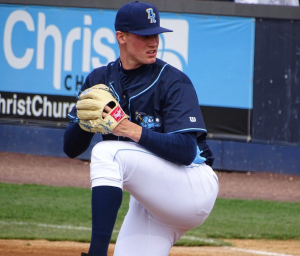As we draw closer to spring training what better time to look at the performances of last season and make a prediction for a player at each level to step up his game.
Not really based on last year’s numbers as he surprisingly struggled at Triple-A Omaha before a roster crunch sent Ryan O’Hearn to Double-A but the last time he repeated a level he dominated before a promotion. That promotion may not be waiting for him this time through but it still shouldn’t stop O’Hearn from a nice bounce-back season. The home park he plays in suits his swing quite well but things just didn’t go his way as exhibited in his .229/.331/.416 line at Werner Park. Perhaps it’s a player reaching his limits but he didn’t give the appearance of a player overexposed and the peripheral stats don’t give that appearance either. With that I expect him to make some minor adjustments as he did prior and exhibit the strength and power he’s shown in the past.
Quite likely the biggest surprise on the farm last season came from right-hander Andres Machado who after struggles in the low minors and Tommy John surgery had a career-altering season. One of just a handful of Royals starters on the farm that averaged better than a K per inning while also keeping his walk rate under 3 per 9. He did this with a rise in velocity to the mid-90s, a late-biting slider and a changeup that showed decent arm speed. Over Machado’s last 11 starts in the minors, he attacked the zone at a 65% clip while striking out 24% of the hitters he faced over 59.2 innings or 9.4 per 9. After a strong finish and more time to develop his secondary pitches, I believe he has an opportunity to zip around some better-known pitchers ahead of him in the farm.
At Double-A Nicky Lopez makes logical sense for him to continue his quick ascension to Kansas City. Once at NW Arkansas, last season the shortstop’s numbers fell off, hitting just .259/.312/.293 in 59 games there, but it wasn’t about being overmatched as his k-rate went up just 4% to a still ridiculously low 11.5%. The ISO rate fell off considerably to just .034 which was something he wanted to address in the Arizona Fall League and did well, pushing it to .185 against some of the best prospects in baseball. Those changes should improve his ISO and allow him to improve his BA and walk rates closer to the numbers he put up in Wilmington prior to the promotion.
Trying to figure out which pitcher will pitch at Double-A or Triple-A is tough enough and then trying to figure out who may breakout of the pack is anyone’s guess. With that said the combination of the most talented pitching prospect and upside in the Royals system will likely start 2018 at NW Arkansas. If Scott Blewett was to take a similar path to building his draft partner Foster Griffin then a bounce up in his age 22 season then he could rocket up the Royals prospect rankings. The stuff is there with a mid-90’s fastball, hammer curve and a changeup that has slowly improved into a more usable pitch and with that stuff he hinted at bigger things on the horizon with a pair of double-digit strikeout performances and a complete game last season. Working with pitching coach Steve Luebber should help Blewett find that consistency start to start the way it did with Jake Junis, Yordano Ventura, and Griffin.
A prospect that the Royals fans should be paying much more attention to will be heading to Wilmington for an opportunity to push his stuck up in a significant fashion. Most know that Rivera was named Royals Player of the Year in Lexington and put together a solid showing with his .310/.364/.468 overall line there but what people don’t realize is just how consistent he was over the final three months of that season, hitting .328/.393/.486 while cutting his k-rate to 15% and slightly improving his walk rate slightly over the seasonal 6% mark. Not known for power yet Rivera’s better than .300 hitting against pitchers from either side should fit well in Wilmington which tends to play better for average than it does power.
Had he stayed healthy last season Gerson Garabito would likely have already pitched for the Wilmington Blue Rocks. When healthy and on the mound he is as talented of a pitcher as the Royals have in the low minors, exhibiting three solid pitches in his fastball, curve, and change. Hitters hit just .184 last season versus the right-hander with lefties hitting just .183 while he improved his k-rate to 23.5% and was 25% prior to the injury, helping him reach a near 4/1 K/BB ratio. If he stays healthy in Wilmington Gerson has the stuff and control to reach Double-A where his low 90’s velocity will present a larger challenge. A reliever to keep on eye on this year in Wilmington could be Cody Nesbit, a hard-throwing sidearmer who struckout 36% of the hitters he faced at Low-A Lexington last year in 18.2 innings.
Despite a slash line that was less in Arizona than some may have wanted Nick Pratto showed an ability to elevate the ball, hitting flyballs at a 42% clip and line drives at 24%. Those numbers should translate into big numbers in the South Atlantic League where he will play half of his home games in the league’s third-best home run park.
The Royals Low-A squad in Lexington has had the worst ERA in the league the last three seasons and while I don’t expect them to be vastly improved I do think a rotation featuring Dan Tillo and Evan Steele could be an improvement. As for the breakout performer, Tillo feels like the most likely name here with his mid-90s fastball and plus slider. At the low levels, he can lean on those two pitches, generate groundball (69% in Burlington) and refine his stuff. His ability to add and subtract from the slider while repeating his mechanics should give him a shot to get to Wilmington at some point this season.
Featured Photo Bill Mitchell Baseball America



I’m guessing you meant Evan Steele instead of Ethan Steele?
fixed
How would you compare Andres Machado’s leap last year to Ventura’s big jump in 2012? I get that Machado isn’t considered the prospect that Ventura was, but sort of the 3-league jump Ventura had in 2012 is very similar to what Machado did last year.
They are very different as Ventura was well known after showing off major league velocity in the summer of ’10. No one really doubted he had a major league arm but the question was whether he could stay healthy as a starter. Machado, on the other hand, wasn’t thought of that highly until flashing a bit at Idaho Falls and blowing up this last season and forcing his way onto the 40 man roster, something that I doubt even Royals officials thought he would do before the season.